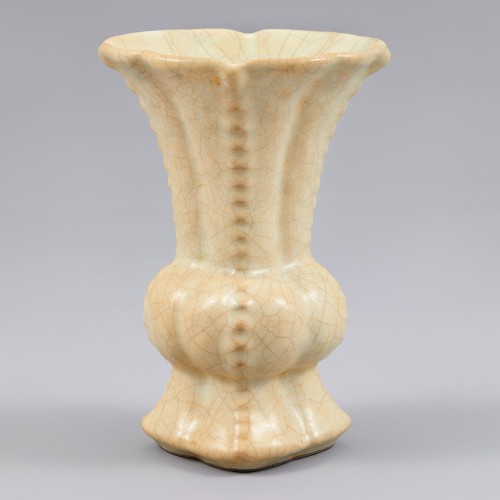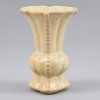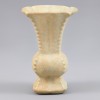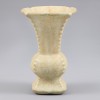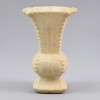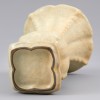작품 정보
꽃잎처럼 펼쳐진 구연부와 길게 뻗은 목, 볼록한 곡선을 이루는 둥근 복부, 그리고 안정감 있는 넓은 꽃 모양의 굽을 지닌 관요(官窯) 화고(花觚)입니다. 화고는 본래 꽃을 꽂는 병의 일종으로, 미적 요소가 강조되어 귀족 계층의 애장품으로 여겨졌습니다.
관요(官窯)는 송대 5대 명요(名窯) 중 하나로, 북송 시기 하남성(河南省) 청량사 부근의 여 관요(汝官窯), 북송 휘종 황제가 설치한 북송 관요, 남송 시기 항주(杭州)에 설치된 남송 관요 등으로 나뉩니다. 도자의 질감뿐만 아니라 유약 색채의 아름다움도 중시하여, 천청, 분청, 미황, 유회색 등 다양한 색상이 있으며, 대체로 유약이 두껍고 표면에 개편(开片)이 나타납니다.
기물의 네 면에 표현된 볼록한 출극(出戟) 장식은 고대 무기인 창 끝에 달린 날을 형상화한 문양으로, 청동기 시대에서 유래된 것입니다. 이는 승리와 영광, 수호의 의미를 담고 있습니다.
퍼지듯 바깥으로 펼쳐진 굽 가장자리에는 철갈(铁褐)색 태토가 드러나 있습니다. 짙은 갈색을 띠는 이유는 도자기 흙에 철분 함량이 높고, 특히 굽 부분에서 환원 소성이 강하게 작용했기 때문입니다. 이러한 굽을 ‘철족(铁足)’이라고 부르기도 합니다.
기물의 안팎에 고르게 나타난 섬세한 빙렬무늬와 뛰어난 광택으로 미루어 보아, 이 화고는 황실이나 귀족 계층을 위한 부장품으로 추정됩니다.
━━━━━
花觚花形敞口,长颈, 鼓腹,造型端庄稳重。花觚原是用于插花的瓶子,强调美感成为贵族阶层的珍藏品。
官窑是宋代五大名窑之一,主要包括北宋时期设于河南省清凉寺附近的汝官窑、由北宋徽宗皇帝设立的北宋官窑,以及南宋时期设于杭州的南宋官窑。
官窑瓷器不仅讲究瓷胎的质感,也非常重视釉色的美感,常见釉色有天青、粉青、米黄、灰绿色等多种色彩。整体上,釉层较厚,瓷器表面常可见到开片的自然纹理,是其典型特征之一。
器物四面凸起的出戟装饰,是仿照古代武器长矛上的刃形图案而制,源自青铜器时代的纹样,寓意胜利、荣耀与守护。
器物足底刮釉垫烧,因瓷土中铁含量高,且烧制时足部受到强还原气氛作用,故呈现出深褐色。也被称作“铁足”。
从器物内外均匀分布的细密冰裂纹和出色的釉面光泽来看,推测此花觚曾用于皇室或贵族的随葬品。
━━━━━
This flowe-mouthed vase from the Ge ware features a widely flared rim resembling flower petals, a long slender neck, a bulbous rounded body with smooth curves, and a stable foot shaped like an open blossom. Originally used for holding flowers, the flower-mouthed vases were regarded as art objects cherished by aristocratic class, emphasizing aesthetic value.
This piece is believed to have been produced at the Ge kilns, one of the most representative ceramic centers in Zhejiang Province during the Song Dynasty. A hallmark of Ge ware celadon is its thick glaze applied over a dark and fine-textured clay body, and the intricate crackle pattern that naturally forms on the surface during firing. Over time, color seeped into these cracks, enhancing the visual depth and organic beauty of the glaze.
The vase is adorned on four sides with protruding ridge-like decorations, modeled after the blades of ancient weapons, a motif originating from bronzeware. These symbolize victory, honor, and protection.
Along the outward-flaring foot rim, the iron-rich body clay is exposed, displaying a deep brown hue. This coloration, called tiezu (“iron foot”), results from the high iron content in the clay and the strong reduction firing effect particularly active around the foot.
Given the evenly distributed fine crackle pattern and the lustrous glaze both inside and out, this flower-mouthed vase was likely used as a burial item for royalty or the aristocracy.
CONDITION
NOTICE
상담/문의 : 02- 730-5601 / 02- 730-7566
